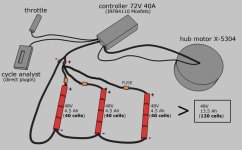Hi there, I have 120 sub-C cells to build a 48V battery, but this is going to be my first e-bike project and I´m not precisely an expert at electrical stuff.
These are the specs of the cells:
-Type: Sub-C
-Chemistry: Nimh
-Voltage: 1.2V
-Capacity: 4500mAh
-Standard Charge: 15 hours @ 300mA
-Rapid Charge: 2 hours @ 3000mA
-Weight: 57g
-Dimension: Height: 43mm / Diameter: 23mm
-Tabs: Yes
They are Tenergy cells (red color) with a rated short-time current up to 40A. I plan to build 3 bateries (48V 4.5Ah each one), then I´ll connect them in parallel to get 48V 13.5Ah, with a short-time current up to 120A. This is to be used with a X-5304 motor and a 72V 40A controller.
Should I connect a fuse to these batteries? 40A fuse? And how do I connect it, maybe between the positive poles of every 48V battery?
I made the following drawing to illustrate the connections:

To recharge the batteries I´ll use 3 different chargers in this way:

These are the chargers:
http://www.powerstream.com/nimh-3pn9.htm
Are these schematic drawings correct?
Thanks.
These are the specs of the cells:
-Type: Sub-C
-Chemistry: Nimh
-Voltage: 1.2V
-Capacity: 4500mAh
-Standard Charge: 15 hours @ 300mA
-Rapid Charge: 2 hours @ 3000mA
-Weight: 57g
-Dimension: Height: 43mm / Diameter: 23mm
-Tabs: Yes
They are Tenergy cells (red color) with a rated short-time current up to 40A. I plan to build 3 bateries (48V 4.5Ah each one), then I´ll connect them in parallel to get 48V 13.5Ah, with a short-time current up to 120A. This is to be used with a X-5304 motor and a 72V 40A controller.
Should I connect a fuse to these batteries? 40A fuse? And how do I connect it, maybe between the positive poles of every 48V battery?
I made the following drawing to illustrate the connections:

To recharge the batteries I´ll use 3 different chargers in this way:

These are the chargers:
http://www.powerstream.com/nimh-3pn9.htm
Are these schematic drawings correct?
Thanks.




